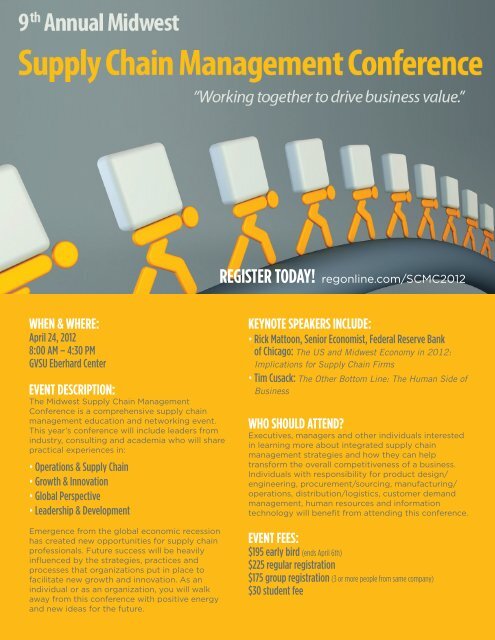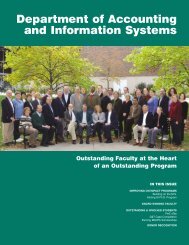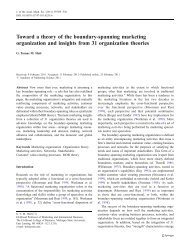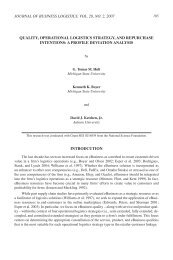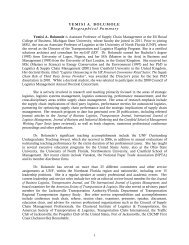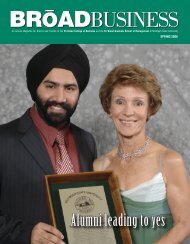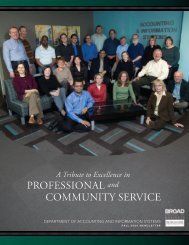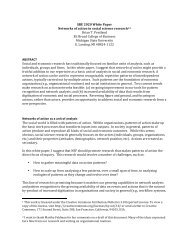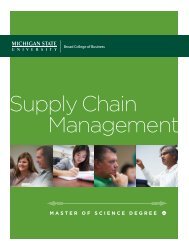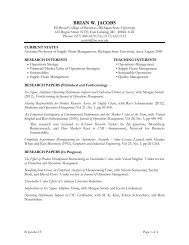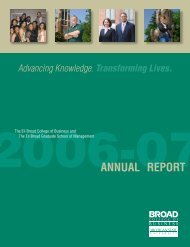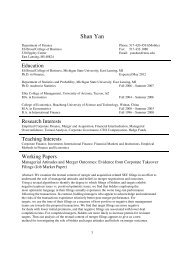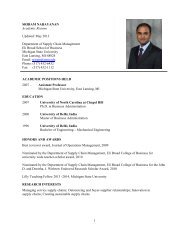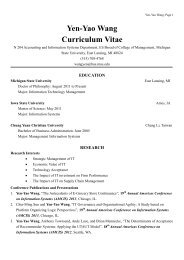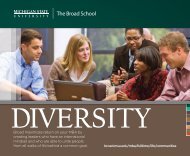register today! - Broad College of Business - Michigan State University
register today! - Broad College of Business - Michigan State University
register today! - Broad College of Business - Michigan State University
Create successful ePaper yourself
Turn your PDF publications into a flip-book with our unique Google optimized e-Paper software.
REGISTER TODAY! regonline.com/SCMC2012WHEN & WHERE:April 24, 20128:00 AM – 4:30 PMGVSU Eberhard CenterEVENT DESCRIPTION:The Midwest Supply Chain ManagementConference is a comprehensive supply chainmanagement education and networking event.This year’s conference will include leaders fromindustry, consulting and academia who will sharepractical experiences in:• Operations & Supply Chain• Growth & Innovation• Global Perspective• Leadership & DevelopmentEmergence from the global economic recessionhas created new opportunities for supply chainpr<strong>of</strong>essionals. Future success will be heavilyinfluenced by the strategies, practices andprocesses that organizations put in place t<strong>of</strong>acilitate new growth and innovation. As anindividual or as an organization, you will walkaway from this conference with positive energyand new ideas for the future.KEYNOTE SPEAKERS INCLUDE:• Rick Mattoon, Senior Economist, Federal Reserve Bank<strong>of</strong> Chicago: The US and Midwest Economy in 2012:Implications for Supply Chain Firms• Tim Cusack: The Other Bottom Line: The Human Side <strong>of</strong><strong>Business</strong>WHO SHOULD ATTEND?Executives, managers and other individuals interestedin learning more about integrated supply chainmanagement strategies and how they can helptransform the overall competitiveness <strong>of</strong> a business.Individuals with responsibility for product design/engineering, procurement/sourcing, manufacturing/operations, distribution/logistics, customer demandmanagement, human resources and informationtechnology will benefit from attending this conference.EVENT FEES:$195 early bird (ends April 6th)$225 regular registration$175 group registration (3 or more people from same company)$30 student fee
EVENT AGENDA:7:30 - 8:00 AM Registration & Breakfast8:00 - 8:15 AM Opening Remarks8:15 - 9:15 AMOPENING KEYNOTE: The US and Midwest Economy in 2012: Implications for Supply Chain FirmsRick Mattoon, Senior Economist, Federal Reserve Bank9:30 - 10:30 AM Concurrent Sessions — First ChoiceOPERATIONS & SUPPLY CHAIN GROWTH & INNOVATION GLOBAL PERSPECTIVE LEADERSHIP & DEVELOPMENTHow to Measure and Minimize Risk inGlobal Supply Chain OperationsPrasad Reddy, Chairman, Twisted X BootsOutcome-Driven Supply ChainManagementSteven Melnyk, <strong>Michigan</strong> <strong>State</strong> <strong>University</strong>Vietnam - A “China Plus One” StrategyNextor Scherbey,CTRMS, Ltd. / NAS Global Trade Ltd.New Supply Chain Talent:Sources and ApplicationsNick Little, <strong>Michigan</strong> <strong>State</strong> <strong>University</strong>10:30 - 10:45 PM Break10:45 - 11:45 PM Concurrent Sessions — Second ChoiceOPERATIONS & SUPPLY CHAIN GROWTH & INNOVATION GLOBAL PERSPECTIVE LEADERSHIP & DEVELOPMENTRFID and the “Internet <strong>of</strong> Things”Steven Miller, SteelcaseFueling Future Growth throughSupplier InnovationPhilip Jones,Goodyear Tire & Rubber CompanyGlobal Sourcing: A Pushmi-Pullyu -The Ultimate Catch-22Mark Mensonides,Magna Mirrors <strong>of</strong> America, Inc.Intrinsic Motivation: Fire in the BellyGene Anderson,Gene Anderson and Associates11:45 - 12:45 PM Lunch12:45 - 1:45 PM Concurrent Sessions — Third ChoiceOPERATIONS & SUPPLY CHAIN GROWTH & INNOVATION GLOBAL PERSPECTIVE LEADERSHIP & DEVELOPMENTTeaming at GE AviationTom Pykosz and Amanda VandePol,GE AviationSupply Chain Innovation:A Design Thinking ApproachAndrew Webster, ExperiencePointDeveloping a Global Strategy- Why Bother?Keith Bezant Niblett,<strong>Michigan</strong> <strong>State</strong> <strong>University</strong>Doing the Workthe Company Cannot DoMark Jones, Marker, LLC1:45 - 2:00 PM Break2:00 - 3:00 PM Concurrent Sessions — Fourth ChoiceOPERATIONS & SUPPLY CHAIN GROWTH & INNOVATION GLOBAL PERSPECTIVE LEADERSHIP & DEVELOPMENTInternational Parts Procurement ModelScott Gladstone, SteelcaseNetwork Strategy and OptimizationTom Glaze, MeijerGlobal Programs to Enhance the SupplyChainSonja Johnson,Van Andel Global Trade CenterManaging TalentScott Patchin, The trU Group3:15 - 4:15 PMCLOSING KEYNOTE: The Other Bottom Line: The Human Side <strong>of</strong> <strong>Business</strong>Tim Cusack4:15 - 4:30 PM Closing RemarksREGISTER TODAY! regonline.com/SCMC2012EVENT PARTNERS:
SESSION DESCRIPTIONS AND SPEAKER BIOSKEYNOTE SPEAKERSThe US and Midwest Economy in 2012: Implications for Supply Chain FirmsRick Mattoon, Senior Economist, Federal Reserve Bank <strong>of</strong> ChicagoRick MattoonRick Mattoon is a senior economist and economic advisor in the economic research department <strong>of</strong> theFederal Reserve Bank <strong>of</strong> Chicago. Mattoon’s primary research focuses on issues that face the Midwestregional economy. Mattoon began his career at the Chicago Fed in 1990. In 1997, he left the bank toserve as a policy advisor for economic development, energy and telecommunications to the Governor<strong>of</strong> Washington. He later served as director <strong>of</strong> policy and legislation for the Washington Utilities andTransportation Commission. He returned to the bank in 2001.Mattoon’s work has appeared in the National Tax Journal, <strong>State</strong> Tax Notes, Public Choice and Society. He is the coauthor<strong>of</strong> a chapter on state and local governments and the national economy in the Oxford Handbook <strong>of</strong> <strong>State</strong> andLocal Government Finance.Mattoon serves on the Board <strong>of</strong> the Chicago Manufacturing Renaissance Council, the Advisory Committee to theChicago Workforce Investment Council, the pension committee <strong>of</strong> the Civic Federation and is a member <strong>of</strong> the JointAdvisory Board <strong>of</strong> Economists to the Governor <strong>of</strong> Virginia. He also serves as a lecturer at the Kellogg School <strong>of</strong>Management at Northwestern <strong>University</strong>.Mattoon received a B.A. from Kenyon <strong>College</strong> and an M.A. from the <strong>University</strong> <strong>of</strong> Chicago.The Other Bottom Line: The Human Side <strong>of</strong> <strong>Business</strong>Tim CusackTim CusackInspiring people to appreciate life, work and relationships, Tim Cusack tours nationally presenting hiskeynotes and trainings for corporations, associations, and health care organizations. When not touring,Tim is a pr<strong>of</strong>essional actor and performs in TV and radio commercials. Tim’s occupations have variedfrom Christmas tree trimmer to Alaskan fisherman and co-host <strong>of</strong> a CBS TV show, as well as a #1morning radio show.Tim volunteers with hospice and Gilda’s Club among other groups. He is married with two children. Inhis spare time, Tim is an avid athlete, pursuing running, cycling and extreme ping pong.EVENT PARTNERS:
TRACK TOPIC: OPERATIONS & SUPPLY CHAINHow to Measure and Minimize Risk in Global Supply Chain OperationsPrasad Reddy, Chairman, Twisted X BootsIn order to be competitive in the market place, it is crucial to view the entire world as a place to source from and startsourcing from any country that can provide the best product both from quality and price points <strong>of</strong> view. However, thereare several risks involved in sourcing from overseas factories and if it is not managed properly, the costs will outweighthe savings. This session addresses how to measure and how to minimize, if not eliminate, much <strong>of</strong> the risk in sourcingfrom overseas factories. The session also includes how to analyze every facet <strong>of</strong> the supply chain risks in sourcing fromoverseas and how to determine a cost factor so an objective and quantitative analysis can be made as to the true cost <strong>of</strong>a product that is sourced from anywhere, whether it is from a company’s own factory or from a contract factory locatedseveral thousand miles away.Prasad ReddyPrasad Reddy was involved in operations and supply chain management for more than 36 years. He started his careerwith Wolverine World Wide as a systems analyst in operations and steadily rose to the position <strong>of</strong> Group Vice President<strong>of</strong> operations by 1982. In that role, Prasad managed all supply chain operations whether the product was manufacturedin the company owned factories or it came from overseas factories. Prasad has dealt with supply chain issues fromvarious countries and some <strong>of</strong> them are Mexico, China, Brazil, Spain, Portugal, Italy, Taiwan, South Korea, Philippines,India, Thailand, Indonesia, Pakistan and Malaysia. After he left Wolverine in 1987, he was involved in various businessturnaround situations and he credits his success in turning around these companies to his knowledge and experiencein handling supply chain related issues. He is currently President and CEO <strong>of</strong> a western boot marketing company calledTwisted X Boots and he acquired this company in early 2009 (from bankruptcy court) and successfully turned it aroundand made it a very pr<strong>of</strong>itable company. Prasad has been an active member <strong>of</strong> Grand Rapids chapter <strong>of</strong> APICS and alsowas president <strong>of</strong> this chapter from 1978 to 1979. He conducted several workshops in supply chain management in GrandRapids and in several other places.RFID and the “Internet <strong>of</strong> Things”Steven Miller, Group Manager - Innovation Management Office, Steelcase Inc.We are on the cusp <strong>of</strong> a dramatic increase in the capability and volume <strong>of</strong> devices that can “sense” and “talk” in theenvironment around us. After spending a long time relegated to mostly “sticker on a box” solutions, RFID technology isseeing new life as a tool that helps the things around us talk. What are the key heuristics that technology leaders shoulduse as they seek to leverage RFID in technology innovations? This session explores advances in RFID technology, theother technologies that complement it, and how one can think about their impact to the way supply chain systems aredesigned.Steven MillerSteven Miller is group manager <strong>of</strong> the Innovation Management Office for Steelcase Inc. Steelcase helps create greatexperiences – wherever work happens. Its brands <strong>of</strong>fer a comprehensive portfolio <strong>of</strong> workplace furnishings, productsand services, inspired by nearly 100 years <strong>of</strong> insight gained serving the world’s leading organizations. Appointed to thisposition in April 2011, Steven is responsible for developing and leading the framework for finding innovative solutions tothe company’s most important technology challenges. Previously, Steven was group manager <strong>of</strong> Asia Pacific InformationTechnology (2006-11) with overall leadership <strong>of</strong> the IT function for that region. Before that, he was manager <strong>of</strong>Collaboration Systems (2005-6), managing the team responsible for implementing a global email system for Steelcase.Steven earned a bachelor’s degree in biochemistry and chemical engineering from <strong>Michigan</strong> <strong>State</strong> <strong>University</strong> in EastLansing.EVENT PARTNERS:
Teaming at GE AviationTom Pykosz, Sourcing Manager and Amanda VandePol, Sourcing Director, GE Aviation SystemsHow can you organize the individuals in operations to gain further improvements and drive the organization to achievegreat goals? For GE Aviation, one answer is through Teaming. Teaming consists <strong>of</strong> a group <strong>of</strong> people who combinedifferent skills and talents to work toward a common purpose or goal. Teaming is one <strong>of</strong> five GE Supply Chain keyinitiatives to drive the strategy <strong>of</strong> increased involvement, development, and empowerment <strong>of</strong> employees.Tom PyskoszTom Pykosz is a Sourcing Manager focusing on operational excellence and continuous improvement at GE AviationSystems. Tom’s primary focus is on the sourcing processes and strategy for the GE Aviation Avionics product lines. Hehas worked as a buyer and has purchased several commodities including electronic components and machined castings.He also spent two years in materials planning with Boeing. Tom graduated from <strong>Michigan</strong> <strong>State</strong> <strong>University</strong> with a degreein Supply Chain Management and completed his MBA at Grand Valley <strong>State</strong> <strong>University</strong>.Amanda VandePolAmanda VandePol is a Sourcing Director at GE Aviation Systems responsible for procurement <strong>of</strong> electronics relatedcommodities. Amanda has also worked as a s<strong>of</strong>tware engineer, technical manager and program manager in her careerat GE Aviation. Amanda graduated from Calvin <strong>College</strong> with a degree in Computer Science and completed her MBA atGrand Valley <strong>State</strong> <strong>University</strong>.International Parts Procurement ModelScott Gladstone, Project Manager, Steelcase Inc.This session outlines fundamental aspects <strong>of</strong> international parts procurement. Discussion will include Candidate PartSelection, Landed Costing Model, Taxes and Duties, Risks, Planning and Inventory Management, Logistics Management,and Warehousing. The speaker will complete the presentation by discussing an example <strong>of</strong> a working international partprocurement model for the furniture industry.Scott GladstoneScott Gladstone is a project manager responsible for developing and implementing the international part procurementmodel for Steelcase Inc. Scott has a Bachelors <strong>of</strong> Science in Electrical Engineering and Systems Science from <strong>Michigan</strong><strong>State</strong> <strong>University</strong>. He was awarded a Master <strong>of</strong> Science in Manufacturing Engineering from the <strong>University</strong> <strong>of</strong> <strong>Michigan</strong>.Scott is a Project Management Pr<strong>of</strong>essional (PMP) and has completed the <strong>Michigan</strong> <strong>State</strong> <strong>University</strong> West <strong>Michigan</strong>Supply Chain Management Certificate Series. Scott has worked on international procurement projects with GeneralMotors, Electrolux, and Steelcase. Prior to working in procurement, Scott has held positions at Steelcase as OperationsManager and Engineering Manager.EVENT PARTNERS:
TRACK TOPIC: GROWTH & INNOVATIONOutcome-Driven Supply Chain ManagementSteven A. Melnyk, Ph.D., Pr<strong>of</strong>essor <strong>of</strong> Operations and Supply Chain Management, The Eli <strong>Broad</strong> <strong>College</strong> <strong>of</strong><strong>Business</strong>, <strong>Michigan</strong> <strong>State</strong> <strong>University</strong>There is a fundamental sea change now taking place – from price-driven, strategically decoupled supply chains tovalue-driven, strategically coupled supply chains. At the heart <strong>of</strong> this is recognition that supply chains are not output(solution) driven but outcome (objective) driven. Yet, rather than delivering one outcome (cost), supply chains are nowbeing asked to deliver varying degrees <strong>of</strong> six key outcomes – cost, responsiveness, security, sustainability, resilience andinnovation. Furthermore, how these six outcomes are mixed is dependent not only on the outcomes but also on theneeds <strong>of</strong> the critical customer and the corporate value proposition. This session presents the fundamental differencebetween output-driven supply chains and outcome-driven supply chains and discusses how supply chain managers mustrethink their role to achieve sustained competitive advantage.Steven A. Melnyk, Ph.D.Steven A. Melnyk, Ph.D. is Pr<strong>of</strong>essor <strong>of</strong> Operations and Supply Chain Management in the Eli <strong>Broad</strong> <strong>College</strong> <strong>of</strong> <strong>Business</strong> at<strong>Michigan</strong> <strong>State</strong> <strong>University</strong>. His research interests include supply chain management, process management and control,metrics/system measurement and new product/process design. He is the lead author for over 14 books and numerousarticles and has won numerous teaching awards.Fueling Future Growth through Supplier InnovationPhilip Jones, Senior Director, Global Strategic Sourcing, The Goodyear Tire & Rubber CompanyGoodyear has made tremendous strides in improving its business results over the past several years and suppliers haveplayed a key role in that transformation. This session reviews the development, implementation and sustainability <strong>of</strong>Goodyear’s supplier innovation process and its contribution to overall corporate performance.Phil JonesPhil Jones is Senior Director, Global Strategic Sourcing for The Goodyear Tire & Rubber Company. He is responsiblefor all non-rubber global raw material and advanced concepts procurement. Mr. Jones joined Goodyear in 2004 andhas held key roles in the procurement, manufacturing, and technical organizations. He joined Goodyear with more than17 years <strong>of</strong> experience focused primarily in the areas <strong>of</strong> supply chain, procurement, and materials management whichhe gained in previous roles at BPAmoco p.l.c, and Georgia-Pacific Corporation. Mr. Jones received a Bachelor <strong>of</strong> Artsdegree in Materials and Logistics Management (Supply Chain) from <strong>Michigan</strong> <strong>State</strong> <strong>University</strong> in 1987. He is a native <strong>of</strong>Franklin, <strong>Michigan</strong>.EVENT PARTNERS:
Supply Chain Innovation: A Design Thinking ApproachAndrew Webster, Director <strong>of</strong> Change and Innovation, ExperiencePointToday’s supply chain leaders face unprecedented complexity and change. As a consequence, traditional analyticalthinking alone cannot deliver tomorrow’s breakthrough strategies or systems. Design thinking may be the antidote. Itaccelerates innovation by adopting a human-centered research lens, and applies structured creativity to help createbetter solutions to enduring challenges. This session <strong>of</strong>fers an introduction to design thinking through an award winninggame experience, where you will be challenged to flex your design thinking skills to create new solutions to realisticproblems.Andrew WebsterAndrew Webster is Director <strong>of</strong> Innovation and Change Solutions at ExperiencePoint, a global business simulationcompany with <strong>of</strong>fices in Toronto and San Francisco. A pioneer in the design <strong>of</strong> online game-based learning,ExperiencePoint has authored numerous leadership simulations in use by thousands <strong>of</strong> executives and managersworldwide. Andrew and his team work with senior leaders at organizations including the United Nations, GE, Nokia, SAP,Bayer, Micros<strong>of</strong>t, Google and various branches <strong>of</strong> the US Armed Forces. Clients also include leading business schoolssuch as Darden, Duke CE, Kellogg, Wharton, UNC, Mt. Eliza, HEC (Paris), LBS, and the <strong>University</strong> <strong>of</strong> Toronto. Inspired bythe challenge to create, Andrew is a key contributor in a company whose work has been recognized for excellence by avariety <strong>of</strong> organizations including the Stanford Research Institute, the American Society <strong>of</strong> Training and Development,and leading technology providers like Adobe. His role finds him responsible for establishing and nourishing partnershipswith the world’s leading executive education providers, and <strong>of</strong>ten trains faculty in the use <strong>of</strong> ExperiencePoint simulations,as well as teaching in programs directly. Andrew is also a driving member <strong>of</strong> the team developing ExperiencePoint’s nextgeneration <strong>of</strong> products and services. Prior to joining ExperiencePoint, Andrew managed the Meeting Design practice atThe Kingbridge Institute in King City, Ontario. In this capacity, he developed new approaches to optimizing collaborationin meeting settings with the application <strong>of</strong> technologies such as decision support, and audience response. He has spokenon the topic <strong>of</strong> meeting design for such associations as the Center for <strong>Business</strong> Intelligence, and has designed andfacilitated innovative meetings for organizations across North America.Network Strategy and OptimizationTom Glaze, Manager – Supply Chain Network Planning, Meijer, Inc.Developing sound and executable supply chain network strategies is essential for any organization looking to leverageits supply chain as a competitive advantage. There are three fundamental drivers that substantiate a company’s needto conduct this type <strong>of</strong> analysis: (1) develop and sustain future growth; (2) rationalize fixed costs; or (3) maximize assetutilization. Any <strong>of</strong> these fundamental drivers is influenced by the external market place and the overall state <strong>of</strong> theeconomy. The end goal, however, is to balance and weigh the service cost trade-<strong>of</strong>fs associated with the long-termstrategic vision <strong>of</strong> the company. The purpose <strong>of</strong> this session is to explore and understand how to conduct a broadbased assessment <strong>of</strong> the supply chain. Further discussion will include tools <strong>of</strong> the trade, supporting processes such assales and operations planning, capacity levers and the theory <strong>of</strong> constraints, developing accurate baselines, crafting andmodeling scenarios, and gaining stakeholder buy in.Tom GlazeTom Glaze is a member <strong>of</strong> APICS and is certified in production and inventory management (CPIM) and is a certifiedsupply chain pr<strong>of</strong>essional (CSCP). He has over 12 years <strong>of</strong> experience, beginning as a consultant, where he spent fiveyears conducting business process reengineering and ERP implementations in the life sciences, consumer packagedgoods, retail/wholesale, automotive, and energy industries. Tom left consulting and entered the retail industry atGap Inc. where he was the Director <strong>of</strong> Logistics Strategy and Engineering responsible for network strategy, capacitymanagement, and inventory modeling. Tom came to Meijer, Inc. in 2010 to oversee and build the network planning teamthat is responsible for network strategy, sales and operations planning, and capacity management. Tom is a Cincinnati,Ohio native and holds a bachelors degree in mechanical engineering, a masters degree in industrial engineering, and aMBA. Tom lives in Grand Rapids, MI with his wife and two children.EVENT PARTNERS:
TRACK TOPIC: GLOBAL PERSPECTIVEVietnam – A “China Plus One” StrategyNestor Scherbey, President, CTRMS, Ltd. / NAS Global Trade Ltd.Many multinationals with investments in China have started to develop a “China Plus One” strategy for Asian sourcingand markets, with the “One” being Vietnam. In the past, foreign manufacturing investments in China were driven by acombination <strong>of</strong> low labor costs and efficiencies gained with the dramatic development <strong>of</strong> new infrastructure in China’ssouthern and coastal regions. In recent years, however, rising wages have diluted the competitiveness <strong>of</strong> Chinesefactories and, tightening labor regulations, appreciation <strong>of</strong> the RMB (Chinese Yuan), environmental and social issuesare all combining to put pressure on manufacturers to consider relocation to the less developed areas <strong>of</strong> western Chinaor, within the southeast Asian region. With Vietnam’s rapidly developing industrial parks, export processing zones andnew infrastructure construction, major U.S., European, Japanese and Korean manufacturers are electing to make newand significant manufacturing investments in Vietnam. They are being joined by Chinese manufacturing firms whoseoperational efficiencies are diluted or compromised by relocation to remote interior regions. Labor costs alone are nolonger decisive or the primary criterion for manufacturing investment and, Vietnam will be a beneficiary <strong>of</strong> the new U.S.-led effort to develop a Trans-Pacific Partnership Agreement in the region. A global strategy that fails to consider thesenew trends runs the risk <strong>of</strong> ignoring key competitiveness factors.Nestor ScherbeyNestor Scherbey served as the Director <strong>of</strong> Global Trade Operations for the Amway Corporation for 20 years, organizingthe launch <strong>of</strong> importing and distributing subsidiaries in over 40 countries in the Americas, Europe and Asia through U.S.export and <strong>of</strong>fshore import operations. In Asia, he was personally involved with the market entry launches and ongoingoperations support activities in Japan, Korea, Taiwan, Thailand, Indonesia, Malaysia, China, the Philippines and Vietnam invarious years since 1983. Amway China Co. Ltd. is the largest direct sales firm in China with sales exceeding USD 2 billionper annum. Since 2001, Nestor has served as an independent customs and trade consultant to various Amway importingfirms in Asia and Europe, as well as with other multinational clients. In 2005 he established a global trading firm in theU.S. with a representative <strong>of</strong>fice in Shenzhen, China that has conducted exports to the U.S. and to Eastern Europe. Since2004, he has also been heavily involved with consulting and business activities in both Thailand and Vietnam, in additionto Korea and Japan. Nestor is a licensed U.S. Customs Broker from the Detroit area where he pioneered applications<strong>of</strong> the U.S. Foreign Trade Zones program in the automotive industry with VW prior to joining Amway and relocating toWest <strong>Michigan</strong>.Global Sourcing: A Pushmi-Pullyu - The Ultimate Catch-22Mark Mensonides, Director <strong>of</strong> Purchasing, Magna Mirrors <strong>of</strong> America, Inc.To be successful in global sourcing, you don’t have to be able to talk to animals, like Dr. Doolittle, but it is imperative thatyou are able to get all the stakeholders going in the same direction if you want to get a lot done. Using case examplesfrom the Automotive Sector, this session explores various motives, defines some key common objectives, and describesthe resulting outcomes and potential implications for our regional supply chains.Mark MensonidesMark Mensonides is the Director <strong>of</strong> Purchasing for Magna Mirrors <strong>of</strong> America. He is a leadership and managementpr<strong>of</strong>essional with over 15 years <strong>of</strong> strategic sourcing, supply chain, logistics, and business development knowledge. Hisindustry experience comes from two <strong>of</strong> the most challenging consumer products and OEM industries and involvementwith over 150 separate supplier companies. Specific experiences include footwear, automotive, leather and textiles,printing, packaging and corrugated, stamping, aluminum die casting, injection molding, extrusion, petro-chemical,logistics, transportation, and indirect materials, services, and business systems. Mark directed and executed strategicsourcing programs resulting in multi-million dollar annual cost reductions through the coordination <strong>of</strong> stakeholderinterests, supplier benchmarking, and decision analysis. He managed commodity optimization strategies resulting indouble digit supply base improvements through supplier pricing negotiations, continuous improvement initiatives, andstrategic sourcing. He also designed, developed, and implemented Lean Manufacturing and Supply Chain initiativesresulting in waste elimination and double digit improvements in productivity, asset utilization, and material flow.EVENT PARTNERS:
Developing a Global Strategy – Why Bother?Keith Bezant Niblett, Assistant Director, Customized and International Programs - Executive DevelopmentPrograms, The Eli <strong>Broad</strong> <strong>College</strong> <strong>of</strong> <strong>Business</strong>, <strong>Michigan</strong> <strong>State</strong> <strong>University</strong>As we entered the third millennium, the debate about any firm <strong>of</strong> any size becoming more global almost ended.Companies now assume that they should globalize at least certain aspects <strong>of</strong> their strategy. All companies play in aglobal market place <strong>of</strong> customers and suppliers. The spread <strong>of</strong> e<strong>Business</strong> Internet tools and web networks providecompelling reasons. With such global focus come demands for high levels <strong>of</strong> delivery, value and service. As more andmore evidence shows, companies that globalize achieve better competitive and financial performance. But globalizing,in the sense <strong>of</strong> spreading supplier or customer networks around the world, is not enough. All companies need todevelop globally coherent and focused strategies. This session discusses the key levers driving international businessdevelopment that all companies need to know when embarking upon a focused global strategy.Keith Bezant NiblettKeith Bezant Niblett is a member <strong>of</strong> the Executive Development Programs team in the Eli <strong>Broad</strong> <strong>College</strong> <strong>of</strong> <strong>Business</strong>at <strong>Michigan</strong> <strong>State</strong> <strong>University</strong>. His focus is on whole program design and development <strong>of</strong> customized and internationalprograms. He is also a speaker and teacher in his specialist areas <strong>of</strong> global and marketing strategy, leadership andchange. Currently portfolio development in Turkey, UAE, Saudi Arabia, India and Korea is absorbing much <strong>of</strong> his time.He worked as a senior manager in the media industry in eight countries for twenty years. He was also a senior directorfor a US based multinational company, developing companies in the Middle East and Asia, and worked globally for aleading consultancy. He was previously a Director at Cranfield <strong>University</strong> School <strong>of</strong> Management, UK and an assistantvice president at Thunderbird Global School <strong>of</strong> Management in Arizona. He is a member <strong>of</strong> the board <strong>of</strong> a globalmanufacturing and sales company and chair <strong>of</strong> the board <strong>of</strong> an international home owners association services company.Much <strong>of</strong> his pr<strong>of</strong>essional life has been absorbed with the leadership and management <strong>of</strong> continuous international changein a large number <strong>of</strong> organizations and their supply chains.Global Programs to Enhance the Supply ChainSonja Johnson, Executive Director, Van Andel Global Trade CenterTaking a closer look at global programs such as trade zones and free trade agreements may be another way to enhancethe performance <strong>of</strong> global supply chains across country borders. Learn how companies benefit from matching the rightglobal programs to their supply chains to get receive maximum results.Sonja JohnsonSonja Johnson is Executive Director <strong>of</strong> the VAGTC and a licensed US Customs Broker with over 15 years <strong>of</strong> experiencespecializing in international logistics and customs compliance issues. Her work history includes: Import Manager for abranch <strong>of</strong>fice for a global logistics provider and she has also worked for several multinational companies supportinginternational trade and global compliance initiatives. She joined the Trade Center in 2003 to provide global tradeexpertise as a consultant and trainer working with <strong>Michigan</strong> businesses developing and enhancing their global tradeinitiatives. As the Associate Director <strong>of</strong> the Center, she worked closely with many <strong>Michigan</strong> businesses, developing andenhancing their global trade initiatives. Sonja has led two trade missions to facilitate business expansion for local smallbusinesses; one to Mumbai, India and one to Guangzhou, China.EVENT PARTNERS:
TRACK TOPIC: LEADERSHIP & DEVELOPMENTNew Supply Chain Talent: Sources and ApplicationsNick Little, Assistant Director - Executive Development Programs, Eli <strong>Broad</strong> <strong>College</strong> <strong>of</strong> <strong>Business</strong>, <strong>Michigan</strong> <strong>State</strong><strong>University</strong>People are critical to success, but demand exceeds supply. How might companies and colleges deal with this? Whatis good new talent? What is the gap? How do you bring new people up to speed fast? Supply Chain Talent AcademicInitiative (SCTAI) research will be shared and discussed.Nick LittleNick Little is Assistant Director <strong>of</strong> Executive Development Programs in the Eli <strong>Broad</strong> <strong>College</strong> <strong>of</strong> <strong>Business</strong> at <strong>Michigan</strong><strong>State</strong> <strong>University</strong>. Nick has extensive industry and international experience in Supply and Supply Chain Management.After completion <strong>of</strong> British Rail’s prestigious Supplies Management Training Scheme, he worked within the UK Railwayindustry and its subsidiaries in Derby and London. He then moved to the UK Post Office where he established a regionaland business unit supply management organization and led a complete review <strong>of</strong> both internal and external Post Officesupply chains reducing annual operating costs by 25% in two years and achieving a recurrent annual saving over £10million ($16 million). Nick also was involved in internal education and development. Since joining MSU in 1995, Nick hasled work on a number <strong>of</strong> benchmarking/research projects, including Supply Chain Performance, Procurement StrategyDevelopment/Implementation, and Indirect Purchases. In addition Nick compiled a Strategy Focus Report on ServicesPurchasing. Nick has a Bachelor <strong>of</strong> Arts in <strong>Business</strong> Studies from Ealing CHE in England and, pr<strong>of</strong>essionally, is qualifiedMCIPS (UK Chartered Institute <strong>of</strong> Purchasing and Supply) and CPSM from ISM (US).Intrinsic Motivation: Fire in the BellyGene Anderson, Gene Anderson and AssociatesDwight D. Eisenhower said, “Motivation is the art <strong>of</strong> getting people to do what you want them to do because they wantto do it.” You undoubtedly studied Maslow’s priority <strong>of</strong> needs in a psychology class, but how about Herzberg? His tw<strong>of</strong>actormodel listed company policy, salary and supervision as job ‘dissatisfiers’ because they can result in Unhappy, but(surprise!) correcting them does not result in Happy. It only results in Not Unhappy. Satisfiers are motivators, and theyinclude achievement, recognition and the work itself.Gene AndersonGene Anderson is a natural teacher. He’s an internationally renowned scientist and magician too, but he’s a teacher firstand foremost. And like so many great teachers, he’s not only an expert on the subject, he’s an expert on presenting it. Sowhen you attend a Gene Anderson program, you’ll learn. And you’ll laugh too. No dull, droning lectures here. From thebeginning you’ll be swept up with Gene’s unbridled enthusiasm, his puckish wit, and his jaw-dropping magic. And you’llcome away with a fund <strong>of</strong> valuable knowledge and skills that you can apply to improve your career and your personallife. When Gene retired from the Dow Chemical Company he was the Global Director <strong>of</strong> Research and DevelopmentLearning. Because <strong>of</strong> his life-long love <strong>of</strong> magic and teaching, he formed Gene Anderson and Associates in Midland,<strong>Michigan</strong> to concentrate on training, facilitating, and performing magic. Since then he has been traveling the globe<strong>of</strong>fering his inspirational training programs and after-dinner presentations to corporations, civic groups, and collegesand universities. He is currently <strong>of</strong>fering five programs, all packed with plenty <strong>of</strong> information, whimsy, and wonder. Geneearned his doctorate in chemistry from the <strong>University</strong> <strong>of</strong> Texas at Austin and did post-doctoral research in electrondiffraction at the <strong>University</strong> <strong>of</strong> Oslo in Norway. He is a member <strong>of</strong> International Brotherhood <strong>of</strong> Magicians.EVENT PARTNERS:
Doing the Work the Company Cannot DoMark Jones, Managing Director, Marker, LLCThis session will explore the impact each manager has in personally creating the conditions and relationships that canenhance employee performance, satisfaction and commitment. Rather than asking what do my employees need todo differently, we will address a more personal question: “How do I need to “BE” different, to be a better leader <strong>of</strong>others?” To illustrate this personal leadership challenge we will examine the case <strong>of</strong> The USS Benfold and the actions <strong>of</strong>its Commander who set about changing himself as a leader, thereby creating the opportunity for his crew, individuallyand collectively to rise from the poorest performing, to the best ship in the Pacific. The dramatic results were achievednot by: a big change initiative, spending more money, or adding people. They were the result <strong>of</strong> a system <strong>of</strong> beliefsfor replacing command and control with commitment and cohesion, and by engaging the hearts, minds, and loyalties<strong>of</strong> workers. The discussion will demonstrate how when leaders reach out to co-workers, listen and learn, and focus oncontinuous development, both the leader and the organization benefit.Mark JonesMark has been instrumental in directing the leadership and organization development functions in multiple globalorganizations, most recently as Director Leadership and Workforce Development for Pfizer Global Research andDevelopment. His consulting work spans a broad spectrum <strong>of</strong> experience in innovation, leadership development,employee engagement, culture change and organization performance improvement. Mark has an MBA is from the<strong>University</strong> <strong>of</strong> Detroit. He is a graduate <strong>of</strong> the Advanced Management Program for General Managers at Harvard <strong>Business</strong>School, and the Leadership Education Master Class at Harvard’s Kennedy School <strong>of</strong> Government. Mark is ManagingDirector <strong>of</strong> Marker, LLC and an Innovation Consultant with Competing Values, LLC. He has served on the faculties <strong>of</strong> theRoss School <strong>of</strong> <strong>Business</strong> and the Executive Education Center at the <strong>University</strong> <strong>of</strong> <strong>Michigan</strong>, Eastern <strong>Michigan</strong> <strong>University</strong>,and the Global Institute for Leadership. His current endeavors focus on helping leaders become more adept in buildingand leading innovative organizations and teams.Managing TalentScott Patchin, Founder, The trU GroupManaging talent can include endless key measures, discussions and interventions. The reality is it comes down to a fewbasic habits by leaders and successfully engaging the talent (people) in the conversation. Here is a scorecard that can beused to help individual leaders assess where they are and focus on a few key areas that will have the most impact. Learnhow to use this talent scorecard to drive the right talent actions and conversations in your organization. As the talentscorecard is reviewed, templates from some <strong>of</strong> the key actions will be shared and discussed. Each attendee will be askedto compare and contrast with their current leadership practices.Scott PatchinScott Patchin founded The trU Group to focus on helping organizations that are concerned about having the rightpeople in the right roles to grow their business and culture. His personal mission is to help others realize the excellencethey were born to achieve, and has developed an expertise around leadership development, executive coaching,managing change, and building processes that develop people. He has held executive level human resource positionsand worked in the manufacturing, banking, and healthcare industries. He is a contributing writer to CORP! Magazine, apublished author, an active blogger around leadership/individual development, and has spoken across the Midwest onthe Talent Scorecard. He recently launched an on-line version <strong>of</strong> the Talent Scorecard(October 2011) with the goal <strong>of</strong>helping individual leaders do a critical review <strong>of</strong> their own habits around managing talent, and develop their own plan toaddress those gaps. Scott has an MBA from the <strong>University</strong> <strong>of</strong> Illinois at Chicago and a BSBA from <strong>Michigan</strong> Tech.EVENT PARTNERS:


